|
|
|
Places in Ladakh |
|
|
Basgo
About 80 kms. west of Leh, Basgo was the capital of
lower Ladakh before the kingdom was united at Leh. Until
recently, this fascinating World Heritage Site was
crumbling into dust, but UNESCO and the Basgo Welfare
Committee have joined forces to restore the ancient
citadel compound. Today, Basgo's Chamba Gompa is one of
the highlights of the Indus Valley. The mural work
inside has been |
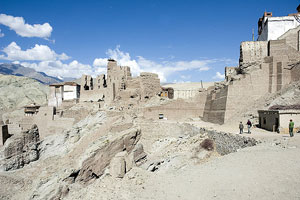 |
|
|
spectacularly restored using
traditional colours and techniques, images of Bodhisattvas and
celestial beings even cover the ceiling. The main building
contains a two-storey statue of Maitreya and there is a second
gompa just downhill with another outsized Maitreya statue. The
ruins of the citadel are scattered across the surrounding
hill. Basgo has no place to eat or sleep but there are
roadhouses for meals in nearby Nimmu, 2 kms. back towards Leh
near the confluence of the green Indus and the murky brown
Zanskar river. A road is slowly being built from here to Padum
in Zanskar. |
| |
|
Central Ladakh: the
Cultural Heartland
The geographical backbone of Ladakh, the Indus Valley,
particularly from Upshi down to Khalatse, is also the
region's historic heartland. All the major sites
connected with the former kingdom's dynastic history are
here, starting with Leh, the capital city since the
early 17th century when Sengge Namgyal built its
nine-storey palace. A few kilometers up the Indus is
Shey, the most ancient capital, with its palace and
temples, their vibrantly coloured murals cleaned and
restored in the mid 1980. Basgo, |
 |
|
|
situated down the river and
right on the road and Tingmosgang, a short way up a
side-valley, served as capital cities when the country was
temporarily divided into two parts in the 15th century, and
both have the remains of forts and temples dating from the
period of their brief glory. Stok, just across the river from
Leh, is the village with which the deposed royal family was
compensated for the loss of its throne. Its palace houses a
museum of artifacts associated with the dynasty, and there is
also a small gompa. |
|
More... |
|
Drass
Drass (3230 m), is situated about 60 kms. west of Kargil on
the road to Srinagar. Drass is a small township lying in the
centre of the valley of the same name. Drass is the first
village after the Zoji La pass. It has become famous as the
second coldest inhabited place in the world due to the intense
cold and snowfall that descends upon the valley during
winters. In winters, the temperature sometimes go down to
minus 50 degrees and heavy snow and strong winds cut off the
town. |
|
More... |
| |
|
Kargil
Kargil (2704 m), situated about 204 kms from Srinagar in
the west and 234 kms from Leh in the east, is the second
largest urban centre of Ladakh and headquarters of the
district of same name. The town lies nestling along the
rising hillside of the lower Suru basin. Two tributaries
of the Suru River that meet here are the Drass and Wakha.
The broad Kargil basin and its wide terraces are
separated from the Mulbekh valley by the 12 kms. long
Wakha |
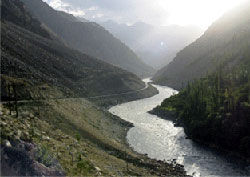 |
|
|
gorge. The land available
along the narrow valley and also the rising hillsides are
intensively cultivated in neat terraces which grow barley,
wheat, peas, a variety of vegetables and other cereals. Kargil
is famous for the fine apricots grown here. In May the entire
countryside becomes awash with fragrant white apricot blossoms
while August, the ripening fruit lends it an orange hue. A
quite town now, Kargil once served as important trading and
transit centre on the two routes, from Srinagar to Leh and to
Gilgit and the lower Indus Valley. Numerous caravans carrying
exotic merchandise of silk, brocade, carpets, felts, tea,
poppy, ivory etc. transited in the town on their way to and
from China, Tibet, Yarkand and Kashmir. The old bazaar
displayed a variety of Central Asian and Tibetan commodities
even after the cessation of the Central Asian trade in 1949
till these were exhausted about two decades back. Similarly
the ancient trade route passing through the township was lined
with several caravanserais. |
|
More... |
|
Leh
Leh, the capital of Ladakh is spreading rapidly in all
directions. Leh is situated in a fertile side valley of the
Indus river at an altitude of 3521 meters, towards the eastern
parts of Jammu and Kashmir. Since the 17th century Leh has
been the capital of the Ladakh region. Leh and Indus Valley
are earlier capitals of the region. The centre is about 10 km
from the river. It was |
|
developed as an
important trading post and market and attracted a wide
variety of merchants from Yarkand, Kashgar, Kashmir,
Tibet and northern India. Tea, salt, household articles,
wool and semi-precious stones were all sold and bought
in the city which became a hub for the business traveler
to South Asia. While Leh has come a long way from the
time when most of the activities took place on its main
street, it still retains its pleasant traditional
|
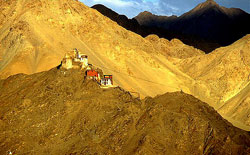 |
|
|
quality. Due to tourism,
there are various hotels and guest houses in the city. Tourism
has certainly had the impacts on the society of Leh. The best
season to visit Leh is from May to November. From traveler by
road we recommend to check if the road is open before to
proceed. We recommend to carry plenty of warm clothes. When
the sun is up it gets quite hot but in the shade it can still
be very cold. Leh is a beautiful destination with so many
attractions and is the center of Tibeto-Buddhist Culture for
ages. Its colorful gompas have attracted the devout Buddhists
from all over the globe. Besides, it is also a favorite hiking
locale and is known for some of the best hikes in the country.
|
|
More... |
| |
|
Nubra Valley
The Nubra Valley, once on the trading route that
connected eastern Tibet with Turkistan via the famous
Karakoram Pass has been opened recently to the tourists.
The Nubra Valley literally means the valley of flowers.
Nubra Valley is situated in the north of Leh. The
average altitude of the valley is about 10,000 feet
above the sea level. The Khardong village, Khalser and
Deskit are the main villages of Nubra valley. At first
glance, the valley seems parched and dry, but this is
prime farming |
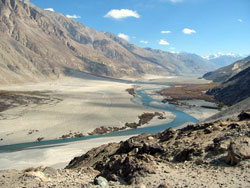 |
|
|
land by Ladakhi standard.
Here the farmers grow apples, apricots and barley and harvest
the orange berries of the tsetalulu. Dotted around the valley
are ancient gompas and ruined palaces and villages are close
enough together to make this magnificent walking country. The
people of Nubra Valley are friendly and hospitable. The Nubra
Valley is indeed a precious treasures of Ladakh where people
still living in the complete isolation for most of the year
from rest of the world in the heart of the great Himalayas.
The main attraction of the Nubra valley is Bactarian Camels
(double hump Camel). These camels can be seen around sand
dunes. Other attractions include Deskit, Samstanling
monasteries and Khardung la Pass (18,380 feet) above sea
level. For tourists its ideal to spend here two to three
nights. However, you do need a permit, which only allows
travel as far as Hunder and Panamik for a maximum of seven
days. You must handover the photocopies of your permit on both
sides of the Khardung La and also by the bridge to Sumur. |
|
More... |
|
Padum
Basking under an endless sky, Padum is the capital of Zanskar,
but don't expect more than a few dusty streets and a bus
stand. Around Padum, the zanskar valley shimmers in the wan
desert light. Yaks and Dzo graze calmly in the fields and the
plain is dotted with small farms and villages. Padum has a
little town mosque, catering to a small community of Sunni
Muslims amd two ruined gompas. A short walk across the valley
is the medieval monastery at Pibiting, topped by a massive
chorten with views over the plain.
Like a smear of whitewash on the mountainside across from
Padum, Karsha Gompa is Zanskar's largest and oldest Buddhist
monastery, dating back to at least the 10th century. Around
150 monks maintain the gompa, helped by the French charity
Solidarijeune. There are two main chambers, both containing
the stunning murals and old trasures. The annual Chaam dances
are held in the July as part of the three day Gustor festival.
You can reach the gompa from Padum by car or a two hours walk
across the exposed plain to the new bridge over the Zanskar
river. There are more historic gompas in the small villages of
Pishu, Stongde and Zangla, accessible by car or on foot from
Padum. a more challenging destination is the isolated gompa of
Phuktal, squeezed into a cave clinging to the side of the near
vertical Shadi gorge. Inside you can see a sacred spring and
some 700 year old murals in the Alchi style. The gompa can
only be reached by walking, typically as part of the Padum to
Darcha trek.
Phugthal
Phugthal is the most spectacularly located monastic
establishment in Ladakh. The Phugthal complex spills out of
the mouth of a huge cave high up in the sheer mountain face of
a lateral gorge through which a major tributary of the
southern Lungnak (Lingti-Tsarap) River flows. It is the most
isolated monastic establishment of Zanskar and its foundation
date back to the early 12th century. One old chappel, among
the several of which it is composed, has frescos and ceiling
decorations reflecting strong Indian artistic and iconographic
influence. Phugthal is accessible from the Padum-Manali
trekking route through a 7 km long trail that branches off
from the Purney Bridge on the main trail. A visit to Phugthal,
including Bardan and Muney monasteries enroute, makes a good 5
days round trek from Padum. This unique monastic establishment
is inhabited by a resident community of about 40 monks.
|
| |
|
Rangdum
Rangdum is the farthest and the most isolated part of
the Suru Valley. Rangdum is an elliptical expanded
plateau surrounded by colourful hills on the one side
and glacier encrusted rocky mountains on the other side.
Rangdum is situated about 130 kms south-east of Kargil
and falls midway between Kargil and Padum. Due to its
remoteness from inhabited parts either of Suru or
Zanskar, this area of wild beauty is
|
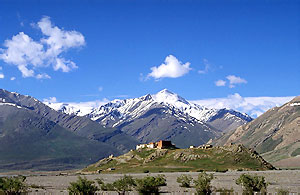 |
|
|
almost haunting,
while its isolation is near perfect even as the unpaved
Zanskar road traverses its length. The chief attraction of
this area is an imposing 18th century Buddhist monastery with
about 40 monks in residence. Perched picturesquely atop a
centrally rising hillock which is entrenched around by the
bifurcated course of a wild mountain stream, the Rangdum
monastery has the aura of an ancient fortification guarding a
mystical mountain valley. The villagers are descendents of the
monastery's agricultural, serf-tenants, who do not own any
land in the region. The monastery enjoys perpetual and
unalienable ownership of the entire valley including the
fields tilled by the villagers, pastures, hills and streams.
Rangdum also serves as an important trekking base. The most
popular trek from here leads to Henaskut near Lamayuru, across
the spectacular gorge of the Kanji valley. This 5-day trek
also forms the last leg of the two week long trans-Himalayan
traverse between Kashmir and Ladakh.
How to reach Rangdum
Rangdum is also connected with Padum. Cars and jeeps can be
hired from Kargil for visiting different places in the Suru
Valley, including Rangdum and Penzila.
Sankoo
Sankoo, about 42 kms south of Kargil is a picturesque area
surrounded by colorful rocky mountains. Sankoo is a new town
with a small bazaar and numerous villages around. Dense
plantations of poplars, willows, myricarea and wild roses fill
the bowl shaped valley, giving it the ambience of a man-made
forest tucked within the mountain ramparts. Two side valleys
drained by large tributary streams of the Suru river, the
Kartse flowing from the east and the Nakpochu descending from
the west, open up on either side of the expanse. The Karste
Valley runs deep into the eastern mountains mass with a large
number of isolated villages tucked within its course. The
4-day trek between Sankoo and Mulbek follows this valley. The
route passes through some very beautiful alpine areas on the
way to the 4950 m high Rusi-la. The high altitude settlement
of Safi and its mixed Buddhist-Muslim population is struck
between the Rusi-la and the Shafi-la over which the final leg
of the trek passes before entering the Mulbek valley. A
southward diversion from the foot of the Rusi-la leads to
Rangdum across the glaciated Rangdum pass where the Karste
River rises. The 3-day trek to Drass across the Umba-la (3350
m) follows the western valley.
Places to see in Sankoo
Sankoo is very popular among local picnic lovers who throng
the area from Kargil town and other places. Locally it is also
popular as a place of pilgrimage to the ancient shrines of
Muslim scholar-saint, Sayed Mir Hashim, who was specially
invited from Kashmir for imparting religious teachings to the
region's Buddhist ruler, Thi-Namgyal of the Suru principality,
following his conversion to Islam during the 16th century. The
shrine is situated in the village of Karpo-Khar on the
outskirts of Sankoo where the chief had his summer palace.
How to reach Sankoo
Sankoo, Panikhar and Parachik are connected with Kargil with
regular bus services. A bus ride from Kargil takes 2 hours to
Sankoo, 3 hours to Panikhar and about 4 hours to Parkachik.
|
| |
|
Suru Valley
The Suru Valley is one of the most beautiful areas of
Ladakh and a rather recent addition to the tourism map
of Ladakh. The Suru Valley forms the mainstay of Kargil
district. Lying nestled along the north-eastern
foothills of the great Himalayan Wall, it extends from
Kargil town, first southward for a length of about 75
kms Upto the expanse around Panikhar, hence eastward for
another stretch of nearly 65 kms upto the foot of the
Penzila watershed |
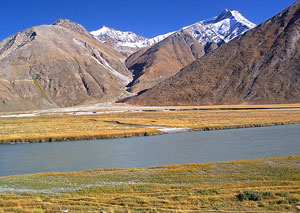 |
|
|
where the Suru valley rises.
The hills of Suru Valley are cultivated intensively than
anywhere else in Ladakh. Enough snow and water during the
winters and fertile land makes it possible to yield two crops
annually. The valleys are especially picturesque in spring
when the apple, apricot and mulberry trees are all in bloom
and in autumn when they are laden with fruits. Its composite
population of about 30,000 - mainly of Tibetan-Darad descent,
are Muslims who had converted their Buddhist faith around the
middle of the 16th century. At Thangbu, a little village, the
traveler gets a first glimpse of the spectacular Nun (7135 m)
– Kun(7935 m) massif which loom over the skyline in their
crystalline majesty. Pahikhar, about 12 kms. away is the base
for treks to Kashmir and Kishtwar. The road goes past the
glaciers of the Nun-Kun massif to descend to Rangdum gompa
with a little stream forming a moat around it, looks like an
ancient fort protecting the valley. Only the basic
accommodation is available at most of the tourist spots of
Suru Valley. |
|
More... |
| |
|
Zongkhul
Zongkhul is the famous spectacular cave monastery of
Zanskar. Zongkhul falls on the Padum-Kishtwar trekking
trail, just before the ascent of Omasi-la Pass begins.
Zongkhul monastery is situated like a swallow’s nest on
the rock face of the Ating Gorge, and associated by
legend with the famous Indian Yogi, Naropa, who lectured
in the Nalanda and Vikramsila Universities. The two
caves in the monastery are said to |
 |
|
|
have been used by the famous
Yogi for the solitary meditation. A footprint on the stone
near the ingress of the lower cave is reserved as that of the
yogi. The frescos on the cave walls are very old and reflect a
high degree of artistic achievement. These are believed to be
the original murals executed by Zhadpa Dorje, the celebrated
scholar-painter of the same monastery who was active about 300
years ago. |
|
 |
|